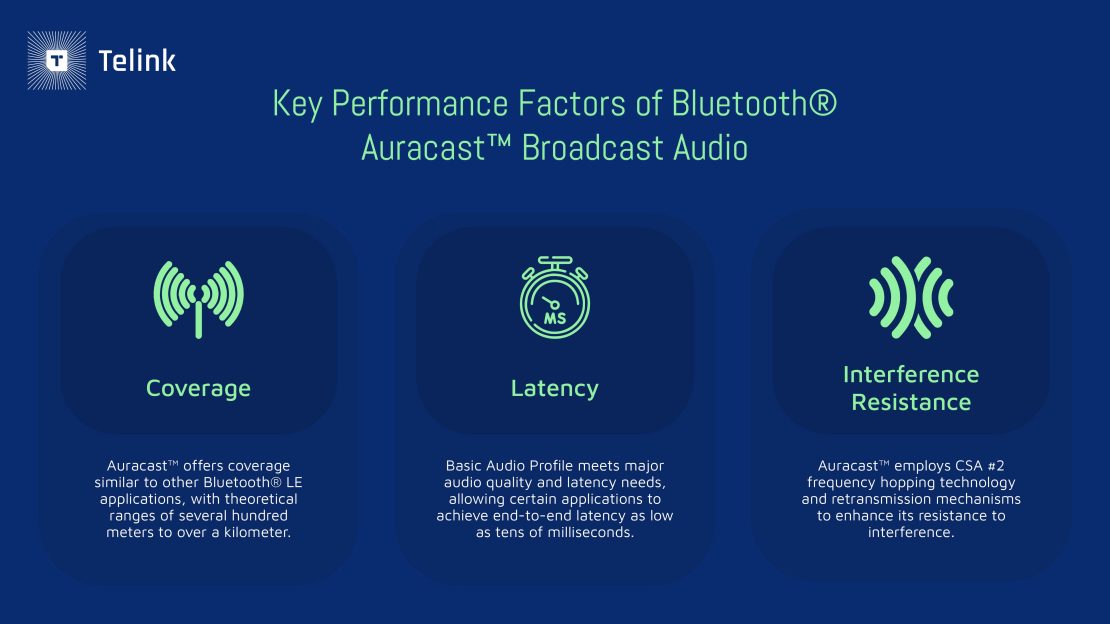



PLEASE ROTATE ME


Telink Staff
July 21, 2023
Technology

Developers can further expand their palette when designing wireless audio products with AuracastTM broadcast audio — here’s how.
How we tune into our surrounding world has been elevated with the advent of Bluetooth® wireless technology. From smartphones to speakers, Bluetooth has become an integral part of our daily lives, allowing us to enjoy the audio we like the way we want — hands-free, intuitively, and with the ones we love.
Over the years, Bluetooth has expanded its applications, moving from its Classic protocol for more convenient personal listening to a low-energy alternative fit for IoT ecosystems, and now to AuracastTM broadcast audio for integrative listening that supports collaborative listening at public venues. As we continue to shape what the world of audio sounds like, developers may have several questions about how Auracast is propelling us toward the future of wireless audio and how it enhances the Bluetooth capabilities we know and rely on. To help answer them, we’ll delve into all you need to know about Auracast, from enhancing current capabilities to reshaping how audio is experienced.
Introduced along with Bluetooth® LE Audio, AuracastTM broadcast audio is a new advancement in Bluetooth technology that enables seamless and efficient audio broadcasting in public spaces. Unlike traditional Bluetooth audio applications, which are primarily focused on connection-oriented point-to-point streaming between devices, AuracastTM allows audio to be transmitted from a single source to multiple receiving devices simultaneously.
The key difference between AuracastTM and traditional Bluetooth audio lies in their intended use cases. While traditional Bluetooth technology is commonly used for personal device connections, such as connecting a smartphone to a wireless headphone, AuracastTM is mainly designed for public audio broadcasting scenarios where a listener can tune into a silent TV at a restaurant, listen to airport public announcements right from their earbuds, or access the music of a live performance for crisp, clear sound that drives out ambient noise. AuracastTM is a new way of boosting our day-to-day experiences by deeply immersing ourselves in sound.

How can AuracastTM help developers augment and adapt audio devices for the evolving demands of listeners? Here’s a quick breakdown of critical performance factors that developers need to consider when developing AuracastTM solutions:
AuracastTM supports a fluid, social, and intertwined listening experience that consumers today expect.
AuracastTM gives developers more possibilities when designing both public and private audio broadcasting solutions. However, there are several considerations to keep in mind when implementing AuracastTM into any product, be it a transmitter or receiver.
Public AuracastTM Transmitters, intended for public spaces such as airports, theaters, museums, and hospitals, must adhere to the Standard Quality Public Broadcast Audio configuration specified in the Public Broadcast Profile (PBP) application specification. This ensures that all receiving devices can access the broadcasted audio content. Product designers can determine additional QoS configurations based on specific application scenarios to strike a balance between audio quality and latency.
Private AuracastTM Transmitters, on the other hand, cater to personal use cases. They can default to higher-quality audio configurations but must also support the standard audio configuration as an option. AuracastTM receiver devices are designed to support broadcast audio configurations based on their hardware resources. This design flexibility allows manufacturers to create tailored solutions for different use cases, ensuring optimal audio performance for both public and private applications.
When implementing AuracastTM, the choice of transmitter devices is crucial. These devices need to adopt a System-on-Chip (SoC) and protocol stack that supports Bluetooth 5.2 and AuracastTM for development. There are no specific limitations on the type and form of these devices. They can be integrated into existing audio source devices such as smartphones, PCs, TVs, and other compatible receivers. Additionally, they can be upgraded through additional hardware extensions like USB dongles or designed as completely new transmitter device forms such as AuracastTM base stations. This versatility allows developers to integrate AuracastTM seamlessly into their existing product lines or create dedicated AuracastTM broadcasting solutions.
How to implement the Assistant functionality is another factor to consider for AuracastTM products. This functionality can rely on platform devices such as smartphones, PCs, or televisions or be integrated within the receiving devices themselves, depending on the product’s use case and implementation cost. By offering a range of flexible implementation options, AuracastTM opens up opportunities for innovative applications and enhanced user engagement.
Existing audio platform devices still predominantly rely on Bluetooth® Classic technology. Therefore, the development of AuracastTM receiver devices needs to consider technological compatibility. Choosing a SoC that supports dual-mode Bluetooth for development is a wise choice. One example is the Telink TLSR9 series audio SoC, which supports dual-mode Bluetooth and has complete Bluetooth certification. It also provides developers with a flexible software development kit (SDK) free of charge for their selection. By leveraging SoCs like the TLSR9 series, developers can expedite the development of AuracastTM-enabled devices and ensure seamless interoperability with existing Bluetooth Classic devices.
AuracastTM primarily targets public service areas where audio messages are broadcasted to the general public, such as theaters, museums, hospitals, airports, transit hubs, restaurants, and auditoriums. In these contexts, privacy of information is not a requirement. Therefore, audio data transmitted via AuracastTM is not encrypted, and receiving devices can freely access and join the broadcasted content. This approach ensures easy access to audio information for all users in public spaces, promoting inclusivity and accessibility.
For private applications, where confidentiality is important, AuracastTM provides an option to encrypt the broadcasted content. Receiving devices can only access the corresponding broadcasted content by entering a password, similar to the familiar Wi-Fi user experience. This encryption capability adds an extra layer of security, ensuring that sensitive audio content remains protected and accessible only to authorized users.
By expanding Bluetooth wireless audio applications from the consumer domain to public service areas, AuracastTM has the potential to revolutionize audio broadcasting. Assistive listening, guided tours, and multilingual support are all expanded to public spaces to expand the traditional bounds of sound and improve access to audio. AuracastTM also creates quiet spaces in locations like cinemas, conference centers, and schools for personal listening.
Research suggests that approximately 60 million potential public places worldwide could adopt AuracastTM technology for service upgrades, thereby driving the widespread adoption of AuracastTM-supported receiving devices such as headphones, TWS earbuds, and hearing aids in the consumer market. The demand for enhanced audio experiences in public spaces, married with the potential benefits offered by AuracastTM, creates a favorable environment for market growth and a suitable stage to transform how we interact with our world.
Choosing the right SoC is essential for developing AuracastTM-enabled devices consumers want. Telink’s best-in-class chips are designed with progress in mind to help developers create competitive, cutting-edge products that not only meet consumer expectations but redefine the standard of audio. Our TLSR9 series audio SoCs ensure seamless integration of existing Bluetooth technologies and compliance with industry standards, allowing developers to accelerate development, ensure compatibility, and unlock the full potential of Auracast broadcast audio in their devices while delivering exceptional audio quality to users.
Future-proof your audio products with Telink. Contact us today or send an email directly to telinksales@telink-semi.com to get started.